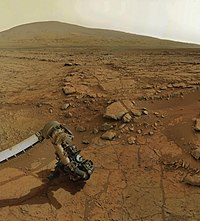
Back Habitabilitat en sistemes de nanes taronges Catalan Habitabilidad en sistemas de enanas naranjas Spanish سکونتپذیری سامانههای ستارهای رشته اصلی نوع کی Persian K-tyypin pääsarjan tähtijärjestelmien elinkelpoisuus Finnish Abitabilità di un sistema planetario di una nana arancione Italian 橙色矮星系の居住可能性 Japanese K형 주계열성계의 생명체 거주가능성 Korean Жизнепригодность системы оранжевого карлика Russian Sự sống ở các ngôi sao dãy chính loại K Vietnamese 橙矮星系統適居性 Chinese
 |
| This article is one of a series on: |
| Life in the universe |
|---|
| Outline |
| Planetary habitability in the Solar System |
| Life outside the Solar System |
| Habitability of... |
K-type main-sequence stars, also known as orange dwarfs, may be candidates for supporting extraterrestrial life. These stars are known as "Goldilocks stars" as they emit enough radiation in the non-UV ray spectrum[1] to provide a temperature that allows liquid water to exist on the surface of a planet; they also remain stable in the main sequence longer than the Sun by burning their hydrogen slower,[2] allowing more time for life to form on a planet around a K-type main-sequence star.[3] The planet's habitable zone, ranging from 0.1–0.4 to 0.3–1.3 astronomical units (AU),[4][better source needed] depending on the size of the star, is often far enough from the star so as not to be tidally locked to the star, and to have a sufficiently low solar flare activity not to be lethal to life. In comparison, red dwarf stars have too much solar activity and quickly tidally lock the planets in their habitable zones, making them less suitable for life. The odds of complex life arising may be better on planets around K-type main-sequence stars than around Sun-like stars, given the suitable temperature and extra time available for it to evolve.[5] Some planets around K-type main-sequence stars are potential candidates for extraterrestrial life.[2]
- ^ Grossman, Lisa. "Sun may not be a 'Goldilocks' star". Science News. Archived from the original on 27 December 2021. Retrieved 16 April 2014.
- ^ a b Shiga, David. "Orange stars are just right for life". New Scientist. Archived from the original on 13 January 2015. Retrieved 16 April 2014.
- ^ Vieru, Tudor. "Life Could Easily Develop Around Orange Dwarfs". Softpedia. Archived from the original on 16 April 2014. Retrieved 16 April 2014.
- ^ Merchant, David (18 June 2009). "Orange Dwarf Stars and Life – Common?". Archived from the original on 16 April 2014. Retrieved 16 April 2014.
- ^ Loeb, Abraham (2017). "Reduced biodiversity of life around Proxima Centauri and TRAPPIST-1". The Astrophysical Journal Letters. 846 (L21): L21. arXiv:1707.07007. Bibcode:2017ApJ...846L..21L. doi:10.3847/2041-8213/aa8860. S2CID 118880329.